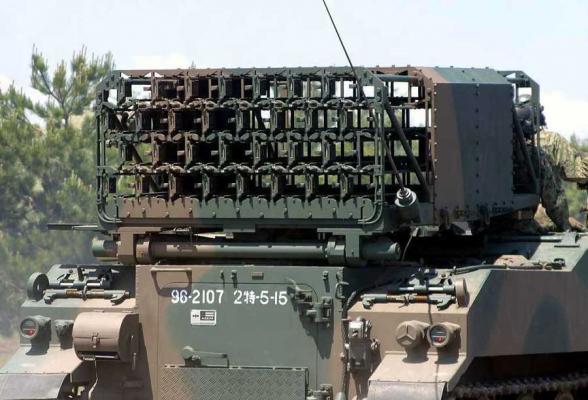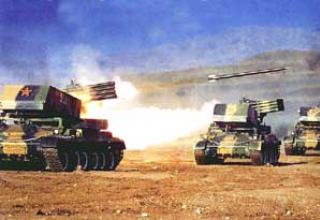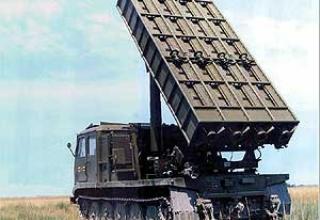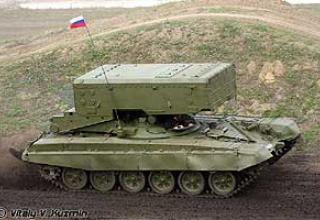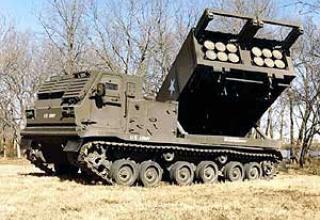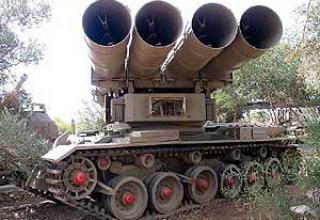The development of the "Type-75" RSF was started by the specialists of the Self-Defence Agency Technical Research Institute of Japanese Self-Defense Forces in 1965. In 1973, two prototypes of this system were tested, and in 1975 the order for serial production of the "Type-75" was issued to the aerospace department of the "Nissan Motor Company" (now IHI Aerospace). Development of the landing gear was made by Komatsu company.
Totally by 1985, 66 combat vehicles were produced for the Japanese self-defense forces. For export there was no delivery of "Type-75" and its components. According to the data provided by the Japanese Self-Defense Forces, by 2008, there were 20 combat vehicles of this system in service of the country's land forces.
It is supposed that in time the Type-75 system will be replaced by the MLRS multiple rocket launcher system, 150 units will be assembled from kits supplied from the USA at the Nissan Motor Company plant.
Composition:
Composition of "Tip-75" RSO:
- combat vehicle (BM) (see diagram) ;
- 131.5mm Uncontrollable Turbojet Propellant (TRS);
- transport and charging machine;
PM "Type-75" is placed on the upgraded chassis of the tracked armored personnel carrier "Type-73" on the classic scheme - in the rear of the vehicle on a rotating platform mounted artillery part, representing a package of cellular type with 30 guides (see photo). With the help of lifting and swiveling mechanisms, it is ensured that the package of guides is pointed in the vertical plane at an angle from 0 to 50° and in the horizontal plane from -50° to +50° from the longitudinal axis of the combat vehicle. The guidance mechanisms are electrically operated and manual duplicating of the guidance drives is provided. Shots may be fired in single shots or in volley. The duration of a full salvo shall not exceed 12s. Battle calculation - 3 persons: commander, mechanic-driver and operator. The crew compartment is located in the front part of the all-welded aluminum alloy hull. The place of the mechanic-driver is shifted to the port side, and the commander - to the starboard side. The operator is located behind the BM commander. The equipment installed at the operator's workplace allows him to perform the calculation of flight task data, pre-check of the TRS, guide package pointing and start control.
BM equipment includes sighting devices, gyroazimuth, radio communication equipment, fire extinguishing means, filtering and night vision devices. The Auxiliary Armament consists of a 12.7 mm machine gun mounted above the commander's hatch. It can be fired at air and ground targets. The tracked chassis has a four-cylinder V-shaped 4ZF air-cooled diesel engine from Mitsubishi Heavy Industries. The engine power is 300 hp. The chassis has five rubberized two-roller support wheels with a leading sprocket at the front and a guide wheel at the rear. The engine compartment is located on the left side of the machine body at the rear of the mechanic-driver. The suspension of the support rollers is individual torsional. When driving on the highway, the launcher reaches a speed of 50 km/h. It is able to overcome climbs steeply up to 30 °, walls up to 0.65 m high and ditches 1.6 m wide, the depth of ford overcome - 1.1 m. Power reserve of 300 km.
The combat vehicle is manually charged using a transport and charging machine on the chassis of an army off-road truck (wheel arrangement 6x6). The recharging time is 15 minutes.
Battery RSZO "Type 75" has a mobile weather station, equipped with a retractable mast with measuring instruments. Meteostation "Type 75" (see photo) is made on the same chassis of the armored personnel carrier "Type 73" and has the following dimensions: length-5.7m, width-2.9m, height in camping position-3.5m, height with the mast raised-12.5m. Wind speed from 0.1 to 30m/s. Crew -4 people, weight -12.5 t. The staff battery of the division includes a fire control machine ("Type 76") with a radar station for target detection.
Uncontrolled turbojet projectile is equipped with a solid fuel single-mode engine, has a maximum flight speed of 700m / s and a maximum range of 14.5 km. The head part (weight 15 kg) is of shrapnel-phase type. The TRS has a weight of 43.1 kg and length of 1856 mm.
Characteristics:
| Maximum firing range, km | 14.5 |
| Length BM, m | 5,78 |
| BM width, m | 2.8 |
| Height in hiking position, m | 2.67 |
| Gross battle weight, kg | 16500 |
| Maximum angle of inclination/elevation, deg | 50 |
| Angle of horizontal guidance, deg | 100 |
Sources:
- Шунков В.Н. "Ракетное оружие" .-Мн.: ООО "Попурри", 2001- 528с.
- Type 75 - Multiple launch rocket system
- IHI Aerospace 130 mm (30-round) Type 75 multiple rocket system (Japan) (http://www.janes.com)

